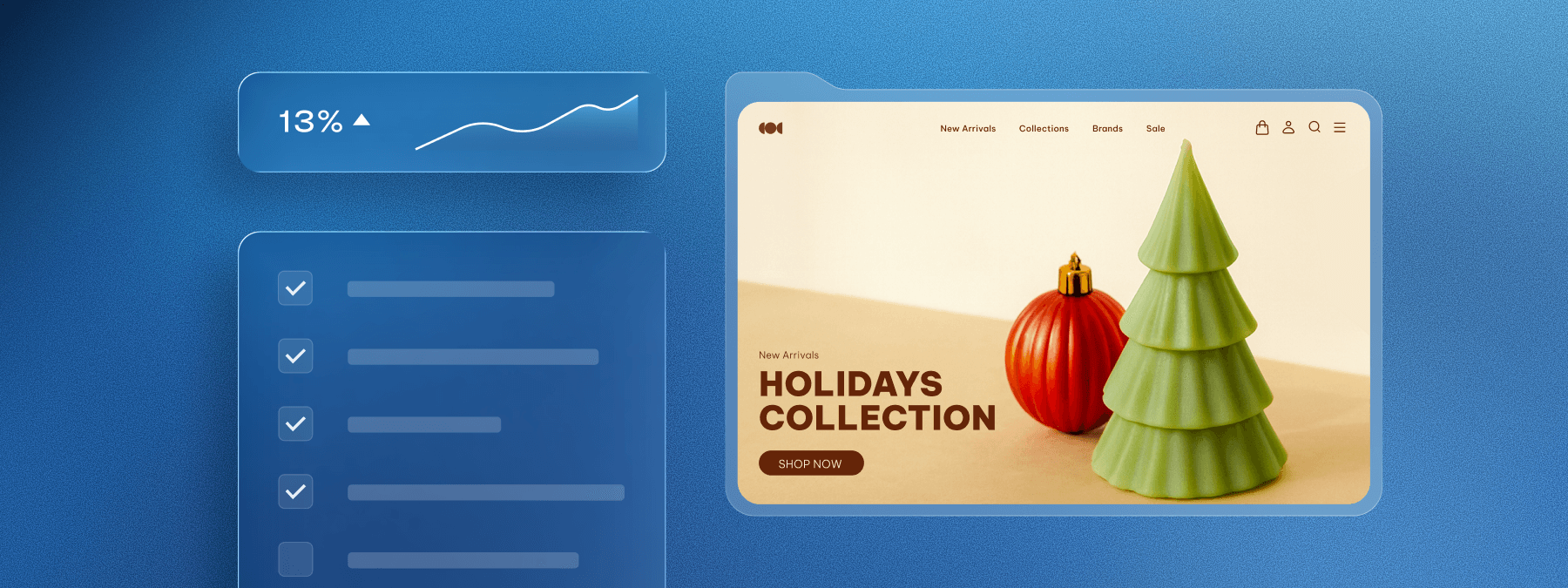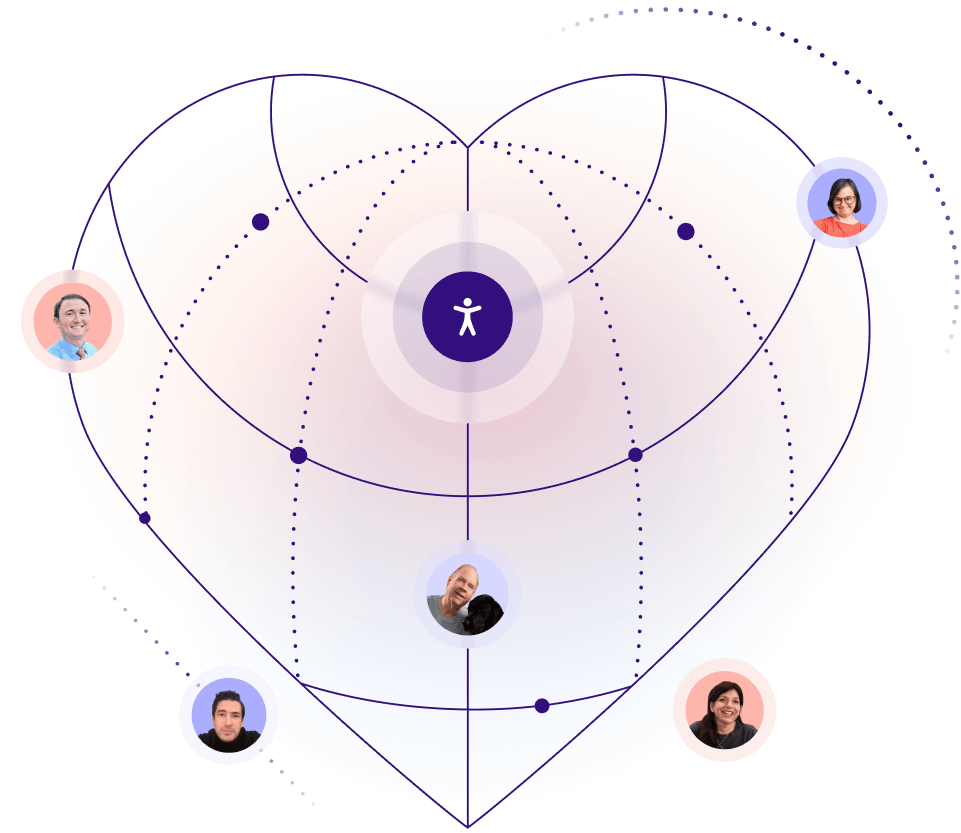The 2025 holiday season will be a big test for eCommerce brands. With the rise of AI and the enforcement of global accessibility regulations, consumers' expectations have changed. Shoppers want more speed, more personalization, more convenience, and they won’t hesitate to switch to competitors if those demands aren’t met.
Industry leaders are already investing in six key trends that will define this season: hyper-personalization, voice commerce, AI-powered search, frictionless checkout, global compliance, and risk management. But there’s a catch: none of these trends work without accessibility.
From personalization algorithms to voice checkout flows, accessibility is what ensures these innovations reach every shopper, not just some. It’s also the one investment that mitigates legal risk while strengthening customer experience.
We surveyed more than 300 eCommerce executives and members of the disability community to understand how retailers are adapting to these trends, and what it means for the 2025 holiday season. This blog is a snapshot of what we found.
Hyper-personalization: Only works when it’s inclusive
Personalization has become a consumer expectation. 71% of shoppers expect personalized experiences when buying online, with tailored bundles, discounts, and homepages that feel like they were designed just for them. Done right, personalization boosts loyalty and lifetime value.
But personalization is only as strong as its accessibility. If dynamic layouts can’t be read by screen readers, or if personalized pricing tools create friction in checkout, your most loyal shoppers may be the ones left behind.
Our survey revealed that retailers themselves recognize a major gap here—and surprisingly, it’s not first-time customers who are most at risk. The full report breaks down who personalization leaves out most often.
Accessibility ensures personalization works as intended. With accessibility features like accessWidget’s session-based interface, retailers can deliver personalized browsing as users customize their experience from keyboard navigation to text size and color contrast.
Voice commerce: From niche to necessity
Born as an accessibility feature for people with vision or mobility disabilities, voice shopping has become mainstream. Nearly half of U.S. consumers have already shopped by voice, and the market is projected to hit $81.8 billion this year.
However, when voice flows aren’t built inclusively—lacking screen reader support, text fallback, or proper error handling—they fail the very customers they were designed to empower.
As accessiBe’s Community Relations Manager Josh Basile, Esq. explained, “Voice commerce is incredible because, without it, I’m often locked out of even having a chance to shop independently. With it, I gain access and a sense of freedom.”
Our research uncovered a sharp disconnect between how eCommerce leaders think about voice commerce and how the disability community experiences it. The details are in the full report.
AI-powered search: Discoverability depends on accessibility
AI chat assistants like ChatGPT, Gemini, and Alexa are changing how shoppers find products. Increasingly, customers skip Google and go straight to AI for recommendations.
That’s good news if your catalog is accessible and structured. If it’s not? You’re invisible.
AI assistants rely on semantic markup, structured data, and clean code to understand and surface products. Accessibility and visibility share the same foundation.
In the full report, we explore which types of content AI assistants are most likely to surface—and where retailers are missing easy wins.
Investing in accessibility means doubling your reach: you gain visibility with human shoppers and with the AI systems they increasingly rely on.
Cart abandonment: The hidden accessibility problem
Cart abandonment rates hover around 70%, making it one of the most expensive problems in eCommerce. Shoppers cite hidden costs, long checkout flows, and site errors as the main reasons they leave.
But those friction points aren’t just usability quirks. They’re accessibility failures.
- An unlabeled form field doesn’t just frustrate—it makes checkout impossible for screen reader users
- An inaccessible payment modal doesn’t just slow things down—it blocks entire purchases
- Missing error messages don’t just confuse—they exclude
Accessible checkout is conversion optimization.
Our survey uncovered just how many retailers know their checkout flows fail assistive technologies. The number is higher than most would expect, and you’ll find it in the full report.
With accessWidget handling common barriers automatically and expert audits by accessServices addressing complex ones, brands can turn checkout from a wall into a gateway.
Compliance & the EAA: A global mandate
The European Accessibility Act (EAA) took effect in June 2025, making accessibility mandatory for nearly all digital consumer services. For eCommerce brands that sell into the EU, failure to comply risks fines, lawsuits, and blocked market access.
Our survey found that the majority of retailers admit they’re not fully prepared for the EAA. The full report reveals how wide this readiness gap really is—and what it means for global expansion.
Accessibility isn’t just about avoiding penalties—it’s about unlocking growth. Brands that align with WCAG 2.1 Level AA can sell confidently into Europe while building trust at home.
Litigation & regulatory heat: A growing risk
Accessibility lawsuits are at an all-time high. Nearly 5,000 cases are projected in 2025, and 69% of them target eCommerce. Small retailers are just as vulnerable as global brands.
Most lawsuits settle, costing between $5K and $25K each—before remediation or reputational costs are factored in. Regulators worldwide are citing WCAG 2.1 AA as the global standard, meaning the bar is only getting higher.
Even businesses with accessible websites can face legal action. With accessiBe’s litigation support, businesses get documentation, expert guidance, and a proven record of success. That’s the kind of assurance retailers need in a high-stakes holiday season.
How accessiBe can help
These six trends are shaping the future of eCommerce—but they deliver the best results when they’re accessible. That’s where accessiBe comes in.
- accessWidget: AI-powered automated accessibility that continuously scans and remediates your site in alignment with WCAG 2.2 AA
- accessFlow: Accessibility management platform for developers enables in-house code-level accessibility, no experience required
- MTCR (Manual Testing & Custom Remediation): Expert testing and remediation for complex flows like checkout, modals, and voice journeys
- accessServices:Audits, VPATs, file remediation, user testing, and accessibility consulting
- Litigation support: Expert legal documentation, consultation, and backup if claims arise, backed by a $15k+ pledge (terms and conditions apply)
Together, these solutions make accessibility achievable, scalable, and sustainable for every eCommerce business.
Your holiday 2025 accessibility checklist: Trends in action

Want to stay ahead this holiday season? Here’s how to turn today’s biggest eCommerce trends into results—with accessibility as the connecting thread:
- Make personalization accessible: Audit your recommendation engines and dynamic layouts with assistive technology.
- Build voice commerce that works for everyone: Test flows with users with disabilites; add text fallback and audio confirmations.
- Optimize product data for AI search: Use structured data and semantic markup so AI assistants can find your products.
- Fix checkout barriers that drive abandonment: Label every form field, provide accessible error messages, and test payment gateways.
- Align your site with global compliance standards: Audit against WCAG 2.1 AA and confirm readiness for the EAA.
- Prioritize accessibility and document your efforts: Publish an accessibility statement, keep audit logs, assign ownership, and secure litigation support in advance.
The trends shaping eCommerce in 2025—personalization, voice, AI search, checkout, global compliance, and litigation defense—aren’t optional. They’re the blueprint for survival and growth this holiday season.
Accessibility is the thread that ties them all together. Without it, personalization excludes, voice fails, AI search skips over you, checkout breaks, compliance falters, and lawsuits rise.
This blog is just the highlight reel. For the full survey results and insights into what your peers are doing right now, check out the complete trend reports here.
Frequently asked questions about the 2025 eCommerce holiday trends
Q1. What are the biggest eCommerce trends shaping the 2025 holiday season?
A1. Key trends include hyper-personalization, voice commerce, AI-powered search and discovery, frictionless checkout, global compliance readiness, and proactive litigation preparedness.
Q2. Why is personalization highlighted as a holiday trend for 2025?
A2. Because consumers expect tailored product recommendations, dynamic layouts, and adaptive content that reflect their browsing history—making accessibility a must when personalization engines generate content that must still work for users with disabilities.
Q3. How is voice commerce playing a bigger role this season?
A3. More shoppers are using voice assistants and smart speakers to browse, compare and purchase gifts. Retailers must ensure voice flows are accessible—providing text fallback, audio confirmations and screen-reader compatibility to reach all users.
Q4. What impact does AI-driven search have on holiday eCommerce for 2025?
A4. AI tools increasingly power product discovery and rankings. Structured product data, semantic markup and inclusive metadata help ensure your store shows up in AI-driven results—and remains usable for people with disabilities.
Q5. What does “frictionless checkout” mean in the context of holiday shopping?
A5. It means fewer barriers between product selection and purchase—streamlined forms, one-click payments, keyboard-friendly fields, clear error messaging—and this must work for every user, including those using screen readers or assistive tech.
Q6. Why is global accessibility and compliance important for holiday eCommerce brands?
A6. Because holiday shoppers cross borders and online stores operate globally. Aligning with accessibility standards (like WCAG 2.1 Level AA) and regulations (such as the European Accessibility Act) ensures your site works worldwide and reduces legal risk.
Q7. How does accessibility tie into litigation risk during the holiday season?
A7. With increased traffic and new promotional flows, accessible gaps become more visible—and thus more litigious. Documenting accessibility efforts, performing audits, and showing good-faith inclusion can mitigate risk during this high-stakes period.
Q8. How can accessiBe help retailers capitalise on these 2025 trends?
A8. accessiBe offers accessibility-focused solutions that align with holiday-trend demands. accessWidget enhances user-experience in real time, accessFlow helps developers write inclusive code, and accessServices delivers audits and documentation—letting retailers execute personalization, voice commerce and AI search while ensuring inclusive design and compliance.


